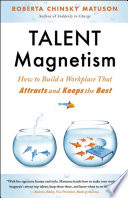

Talent Magnetism refers to the ability of organizations to attract, retain, and develop top talent. This concept emphasizes that in today's competitive landscape, attracting the right employees is not just about offering competitive salaries; it's about creating an environment where talent feels valued, engaged, and inspired. The book delves into the psychology of talent attraction, highlighting the importance of a strong organizational culture, clear vision, and a commitment to employee development. By understanding what makes an organization appealing to potential employees, leaders can create a more effective recruitment strategy that goes beyond traditional methods.
Continue readingThe culture of an organization plays a pivotal role in attracting and retaining talent. In 'Talent Magnetism', the author discusses how a compelling culture can serve as a magnet for top talent. This includes establishing core values that resonate with employees, fostering an environment of trust and collaboration, and promoting a sense of belonging. The book provides practical tips for leaders on how to cultivate a positive workplace culture that not only attracts talent but also enhances employee satisfaction and productivity. A strong culture can differentiate an organization in a crowded market, making it a desirable place to work.
Continue readingLeadership is a critical component in the process of attracting and retaining talent. The book emphasizes that leaders must embody the values and culture of the organization and actively engage with employees. Effective leaders create a vision that inspires employees and encourages them to contribute to the organization's success. The author discusses various leadership styles and their impact on employee engagement and retention. By fostering open communication, providing feedback, and recognizing achievements, leaders can create a loyal workforce that is motivated to stay with the organization long-term.
Continue readingInvesting in employee development is essential for creating a talent magnet. The book outlines the importance of continuous learning and growth opportunities for employees. Organizations that prioritize training, mentorship, and professional development not only enhance their employees' skills but also demonstrate a commitment to their career progression. This investment leads to higher job satisfaction, increased loyalty, and a stronger employer brand. The author provides insights on how to implement effective training programs and create a culture of learning that attracts ambitious talent looking for growth.
Continue readingA strong employer brand is crucial for attracting top talent. 'Talent Magnetism' explains how organizations can build and communicate their employer brand effectively. This involves showcasing the unique aspects of the workplace, such as company values, culture, and employee success stories. The author emphasizes the use of social media, company websites, and employee testimonials to enhance visibility and appeal to potential candidates. A well-defined employer brand not only attracts talent but also creates a sense of pride among current employees, fostering retention and engagement.
Continue readingEmployee engagement is a vital factor in talent retention. The book discusses the link between engagement and productivity, noting that engaged employees are more likely to perform at higher levels and remain with the organization. The author provides strategies for measuring and improving employee engagement, such as conducting regular surveys, creating feedback loops, and recognizing employee contributions. By actively engaging employees and addressing their needs and concerns, organizations can create a loyal workforce that is committed to the organization’s goals.
Continue readingThe landscape of talent acquisition is constantly evolving, influenced by technological advancements and changing workforce dynamics. 'Talent Magnetism' explores emerging trends in recruitment, such as the use of artificial intelligence, data analytics, and remote work. The author discusses how organizations can adapt their talent acquisition strategies to remain competitive in the face of these changes. By embracing new technologies and understanding the preferences of the modern workforce, organizations can enhance their recruitment efforts and ensure they attract the best talent available.
Continue reading